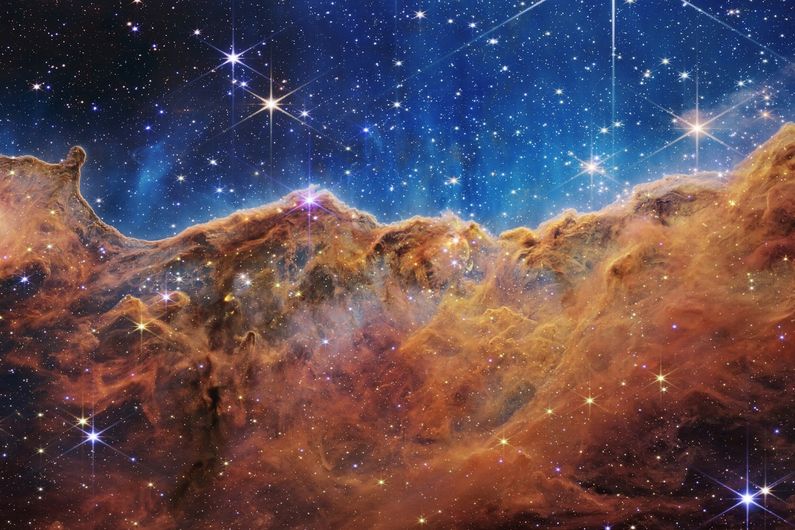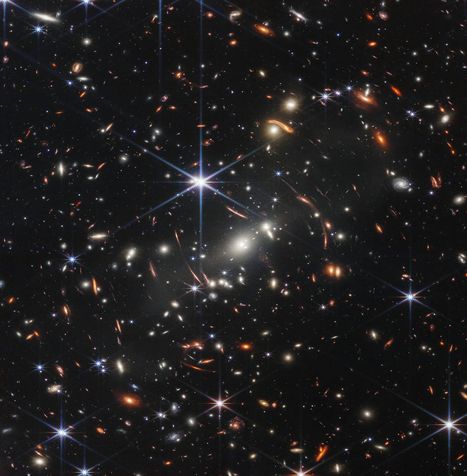James Webb Space Telescope: finally, the edge of the Universe and beyond
- UdeMNouvelles
01/18/2024
- Béatrice St-Cyr-Leroux
Stardust, cosmic cliffs, swirls of colored gas, fascinating infrared: the space observatory stationed 1.5 million kilometres from Earth reveals its first harvest of data.
Launched in 2021 on Christmas Day, the James Webb Space Telescope is the most complex, precise and powerful space observatory ever built.
The telescope's unrivalled resolution and sophistication are due in no small part to the many cutting-edge devices it contains, including a guidance camera and a scientific instrument developed by researchers at Université de Montréal's Institut de recherche sur les exoplanètes (iREx).
Now these same scientists, under the direction of René Doyon, a professor in UdeM's Department of Physics, can see the fruit of their efforts and expertise, as initial data captured by the telescope has been made public.
The first photo taken by James Webb was released by U.S. President Joe Biden on July 11, 2022, and is of unprecedented color and clarity. It is the deepest, sharpest infrared image yet taken of the distant Universe: a cluster of galaxies formed over 13 billion years ago.
Four more images were then unveiled live on July 12 from NASA's Goddard Space Flight Center in Greenbelt, Maryland. The images showed the Carina and Southern Ring nebulae in unparalleled sharpness, in addition to Stephan's Quintet, a visual grouping of five galaxies.
James Webb's first-ever spectroscopy of the exoplanet WASP-96 b, located 1,000 light-years from Earth, was also made public. Using this technique to determine the chemical composition of a distant object, the telescope captured the distinct signature of water, as well as evidence of clouds and haze.
Nathalie Ouellette, an astrophysicist, iREx coordinator and communications scientist for the James Webb Telescope, tells us more about these remarkable images.
The images revealed clouds of gas and dust expelled by dying stars, galactic interactions and hitherto unseen stellar birth zones. What do you consider to be the most significant discoveries?
Firstly, like the general public, I was struck by the beauty of the images - they're so exquisite! Secondly, it's hard to say which image is my favorite, I guess it's like choosing your favorite child.
The exoplanet spectrum is a favorite for me, because a Canadian instrument made it, and because it proved the presence of water and clouds, allowing us to rectify discoveries that had been based on less precise and sensitive data. Usually, when you're looking at exoplanets, the data don't always align; not so with James Webb, whose data turned out to be crisp and clean and revealed some incredible things.
Also, as my research focuses on galaxy formation and evolution, I found the Stephan Quintet image spectacular, giving new insight into how galactic interactions may have driven galaxy evolution in the early Universe.
So these images are truly unprecedented for the human eye?
Yes, because they show light that the human eye cannot see. The Hubble telescope looked mainly at visible light, but James Webb looks into the infrared, enabling us to detect different phenomena.
For example, nebulae are somewhat mysterious objects because they are very dusty; there is a lot of gas blocking visible light. However, with infrared, we can penetrate the dust and obtain images like those of the Southern Ring and Carina nebulae.
Are the photos the result of some kind of manipulation?
Yes, and the team that produced the images for the unveiling is amazing. Remember, it's not an easy task to make invisible light visible. It required the work of artists and scientists who were able to translate infrared into the colours we can see. And the colours are not chosen at random: they serve to emphasize certain scientific and artistic aspects of the objects.
What will astrophysicists be able to do with the photos unveiled today?
There's still a lot of analysis to be done. The images were taken in just a few days, if not weeks. We're not even talking in terms of months!
It's like opening a box full of jewels. We want to look at everything, individually, carefully. There's a lot to discover in the images. It's as if there's a galaxy hidden in every pixel. The discoveries seem endless.
The telescope's scientific operations have also just begun. Scientists and astronomers from all over the world are beginning to take possession of the telescope for their own projects.
And what's next for you at iREx's, using the Webb?
One of the first and most exciting programs to be carried out with James Webb is the observation of the planets in the TRAPPIST-1 system. This is the biggest Canadian program for the first year, and is led by Université de Montréal Ph.D. student Olivia Lim. As with the exoplanet presented today, Olivia will be looking at the atmosphere of these exoplanets, which are rocky and could therefore resemble the Earth. We're looking for a bit of an Earth twin, and maybe we'll find it in the TRAPPIST-1 system.
The James Webb Telescope helps scientists around the world peer into the outer reaches of the Universe, learn more about the composition and habitability of exoplanets, and study the life cycle of stars.














